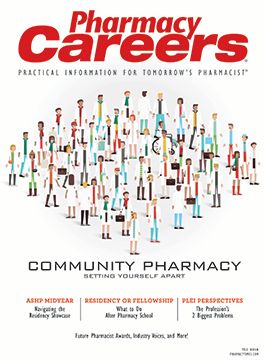Publication
Article
Pharmacy Careers
Residency, Fellowship, Both, or Neither: Which Should I Choose After Pharmacy School?
Author(s):
Differentiation has never been more critical for the individual pharmacist in any other point in history than it is right now.
Try the unofficial quiz made just for this article to find out — then read on!
With the number of licensed pharmacists approaching the amount of open pharmacist positions, the market has become, particularly in some metro areas, saturated with more pharmacists than jobs. Differentiation has never been more critical for the individual pharmacist in any other point in history than it is right now.
One way to differentiate yourself and perhaps get more credentials right after pharmacy school is by taking on a residency, fellowship, or both. But, what are the differences between them? Do you have to complete a residency before a fellowship? Which path should you choose?
Let’s take a look at both types of learning opportunities, along with some truths and myths that follow them around, and, best of all, let’s give you some questions to ask yourself about which type of postgraduate education is right for you.
History of Residencies and Fellowships
According to the American Association of Colleges of Pharmacy, residencies in pharmacy first appeared in the 1930s and were branded more like internships. In 1962, the American Society of Health-Systems Pharmacists (ASHP) first established residency accreditation, with the goal of standardizing this type of postgraduate experience.1 They’re currently labeled by year of postgraduate experience—a postgraduate year 1 (PGY1) residency occurs after the first year of postgraduate education, a PGY2 tends to be more specialized, and occurs after the second year, and so forth. There have even been mentions of PGY3 and PGY4 residencies for pharmacy, much like in medicine.2
Fellowships were originally established in medicine as more research-focused, postresidency experiences. Many fellowships in pharmacy had origins in the 1970s through 1990s.3 However, pharmacy’s approach to fellowships has been different in that a student does not necessarily need to complete a residency in pharmacy first before moving on to a fellowship. In fact, completing a residency in pharmacy prior to a fellowship as a requirement is a myth.
Similarities and Differences Between Residences and Fellowships
Although it is difficult to generalize because each residency and fellowship is different, the elements, similarities, and differences between fellowships and residencies are laid out in the Table.

There are benefits to completing a residency first, if you desire to ultimately work in a hospital setting, or really enjoyed therapeutics or want to learn more about general medicine. If specializing in a therapeutic area is your style, then a PGY2 in addition to a PGY1 might be in order. Managed care is another type of residency that could almost feel more like a fellowship because it sometimes deals in administrative or managed lives rather than direct patient care.
Fellowships generally are within the pharmaceutical industry, government, academia, or all of these. They can either be 1, 2, or up to 3 years in duration. Relative to the pharmaceutical industry, they can focus on clinical research, medical affairs, drug information, clinical research, health economics, or several other areas within a pharmaceutical company. They usually combine social and administrative teaching topics within academia, and government involvement in a fellowship may include work at a governmental agency, like the FDA or NIH.
Where to Find Residencies & Fellowships
Start with your pharmacy school’s director of residencies and fellowships. There is, of course, the ASHP Residency Match Program, and ACCP has a database of residencies and fellowships. AACP has a list of out-of-the-box or nontraditional pre- and postgraduate experiences. Now FellowMatch exists as well, which is part of the Industry Pharmacists Organization. AMCP also has a listing service for fellowships and residencies.
Last but certainly not least, you can go to the hospital site of your choice, or the drug company you’ve always wanted to work with, or the entity in health care you admire and check their website for post graduate opportunities. If one doesn’t exist, why not ask and see if you could start one?
The Best Advice Is to Get Started
Talk to your professors. Take APhA’s Career Pathway Evaluation Program for Pharmacy Professionals, or any quiz that helps you understand yourself.4 Get educated during your education, and don’t forget to keep your grades up, and sign up for those extracurricular activities that demonstrate leadership qualities—all important for your applications.
Good luck in whatever path you choose!
Erin Albert, MBA, PharmD, JD, PAHM, is a health outcomes pharmacist and pharmacy fellowship director for Myers and Stauffer, LC, a co-host of The Pharmacy Podcast, writer, entrepreneur, attorney, preceptor, career coach, and STEM advocate. More on her at her blog, www.erinalbert.com.
References
- American Pharmacists Association. Requirements of post-graduate residency training background prepared for the 2007-08 APhA policy committee. aacp.org/governance/COMMITTEES/professionalaffairs/Documents/RequirementofPost-GradResidencyTrngBackground0708APhAPolicyCmte.pdf. Accessed September 12, 2016.
- Jennings, D. Is PGY3 the future of clinical pharmacy training? Pharmacy Times website. pharmacytimes.com/contributor/douglas-jennings-pharmd-fccp-faha/2016/04/is-pgy3-the-future-of-clinical-pharmacy-training. Published April 6, 2016. Accessed September 12, 2016.
- Rutgers pharmaceutical industry fellowship program history. Rutgers University website. http://pharmafellows.rutgers.edu/history.php. Accessed September 12, 2016.
- American Pharmacists Association. APhA career pathway evaluation program for pharmacy professionals. APA website. pharmacist.com/apha-career-pathway-evaluation-program-pharmacy-professionals. Accessed September 12, 2016.







